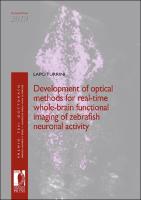Development of optical methods for real-time whole-brain functional imaging of zebrafish neuronal activity
| dc.contributor.author | Turrini, Lapo | |
| dc.date.accessioned | 2022-05-31T10:35:55Z | |
| dc.date.available | 2022-05-31T10:35:55Z | |
| dc.date.issued | 2020 | |
| dc.identifier | ONIX_20220531_9788855180702_917 | |
| dc.identifier | OCN: 1237005600 | |
| dc.identifier.issn | 2612-8020 | |
| dc.identifier.uri | https://library.oapen.org/handle/20.500.12657/55633 | |
| dc.description.abstract | Each one of us in his life has, at least once, smelled the scent of roses, read one canto of Dante’s Commedia or listened to the sound of the sea from a shell. All of this is possible thanks to the astonishing capabilities of an organ, such as the brain, that allows us to collect and organize perceptions coming from sensory organs and to produce behavioural responses accordingly. Studying an operating brain in a non-invasive way is extremely difficult in mammals, and particularly in humans. In the last decade, a small teleost fish, zebrafish (Danio rerio), has been making its way into the field of neurosciences. The brain of a larval zebrafish is made up of 'only' 100000 neurons and it’s completely transparent, making it possible to optically access it. Here, taking advantage of the best of currently available technology, we devised optical solutions to investigate the dynamics of neuronal activity throughout the entire brain of zebrafish larvae. | |
| dc.language | English | |
| dc.relation.ispartofseries | Premio Tesi di Dottorato | |
| dc.subject.other | zebrafish | |
| dc.subject.other | calcium imaging | |
| dc.subject.other | light-sheet microscopy | |
| dc.subject.other | epilepsy | |
| dc.subject.other | behaviour | |
| dc.title | Development of optical methods for real-time whole-brain functional imaging of zebrafish neuronal activity | |
| dc.type | book | |
| oapen.identifier.doi | 10.36253/978-88-5518-070-2 | |
| oapen.relation.isPublishedBy | bf65d21a-78e5-4ba2-983a-dbfa90962870 | |
| oapen.relation.isbn | 9788855180702 | |
| oapen.relation.isbn | 9788855180696 | |
| oapen.relation.isbn | 9788855180719 | |
| oapen.series.number | 85 | |
| oapen.pages | 200 | |
| oapen.place.publication | Florence |

